 The big new frontier in biomedicine is the vast landscape of the microbiome. Although it only amounts to a few pounds of muck in your colon, it contains 90% of the genetic material (DNA and RNA) in your body. There are thousands of different bacteria, fungi, and viruses that live in a healthy colon. More importantly, they are not just hanging out getting a free ride, shelter, and food stamps. The microbiome functions as a complex endocrine organ by producing all sorts of signaling molecules that control various aspects of our body as well as manufacture the primary food the cell of our colon eats – short-chain fatty acids.
The big new frontier in biomedicine is the vast landscape of the microbiome. Although it only amounts to a few pounds of muck in your colon, it contains 90% of the genetic material (DNA and RNA) in your body. There are thousands of different bacteria, fungi, and viruses that live in a healthy colon. More importantly, they are not just hanging out getting a free ride, shelter, and food stamps. The microbiome functions as a complex endocrine organ by producing all sorts of signaling molecules that control various aspects of our body as well as manufacture the primary food the cell of our colon eats – short-chain fatty acids.
 Our brain controls the body through nerve impulses, the glands through hormones, and the gut through signaling molecules. They all work together to produce either health or disease. The gut is particularly sensitive to generating disease for us because different bacteria, fungi, and viruses produce different results, some good and some bad. Which type of bacteria we have growing inside our gut depends upon what we eat and how much stress we are under. As always, everything affects everything else in the body. One consistent finding that has been showing up is that the more healthy you are the greater the diversity of gut bacteria you have. The less variety of gut bacteria you have, the more prone to sickness you are.
Our brain controls the body through nerve impulses, the glands through hormones, and the gut through signaling molecules. They all work together to produce either health or disease. The gut is particularly sensitive to generating disease for us because different bacteria, fungi, and viruses produce different results, some good and some bad. Which type of bacteria we have growing inside our gut depends upon what we eat and how much stress we are under. As always, everything affects everything else in the body. One consistent finding that has been showing up is that the more healthy you are the greater the diversity of gut bacteria you have. The less variety of gut bacteria you have, the more prone to sickness you are.
 There is also the issue of just what strains of bacteria you have living inside you. Bad guy bacteria love to eat junk food while good guy bacteria like fiber foods. This has led some people to assume that this means we should eat only plants, but in reality, the connective tissue in muscle meats is also a type of fiber to the good guy bacteria. Nevertheless, many unprocessed plant foods are high in fiber and do support a healthy gut microbiome. This understanding has led the government to recommend that we consume at least 25 grams of fiber each day, although 50 to 100 grams would be even better. Most Americans eat less than 15 grams of fiber per day.
There is also the issue of just what strains of bacteria you have living inside you. Bad guy bacteria love to eat junk food while good guy bacteria like fiber foods. This has led some people to assume that this means we should eat only plants, but in reality, the connective tissue in muscle meats is also a type of fiber to the good guy bacteria. Nevertheless, many unprocessed plant foods are high in fiber and do support a healthy gut microbiome. This understanding has led the government to recommend that we consume at least 25 grams of fiber each day, although 50 to 100 grams would be even better. Most Americans eat less than 15 grams of fiber per day.
 These recommendations were based on logical thinking, not actual intervention studies. Dietary intervention studies are very difficult to perform because it is very difficult to get people to actually eat differently than they are used to. Lots of observational studies show what I mentioned above – high diversity of good guy bacteria is associated with better health outcomes. But this does not prove that this actually causes greater health. Well, just last week a study performed by Stanford tried to study this very subject. High fiber consumption is associated with better health outcomes, as is the consumption of high-probiotic foods. The question that has been running around for years now is which is better for you, a high-fiber diet or a diet high in fermented high-probiotic food. Or in other words, feed the good guys you already have or constantly dump in new loads of good guys? Here is a link to the results: https://med.stanford.edu/news/all-news/2021/07/fermented-food-diet-increases-microbiome-diversity-lowers-inflammation
These recommendations were based on logical thinking, not actual intervention studies. Dietary intervention studies are very difficult to perform because it is very difficult to get people to actually eat differently than they are used to. Lots of observational studies show what I mentioned above – high diversity of good guy bacteria is associated with better health outcomes. But this does not prove that this actually causes greater health. Well, just last week a study performed by Stanford tried to study this very subject. High fiber consumption is associated with better health outcomes, as is the consumption of high-probiotic foods. The question that has been running around for years now is which is better for you, a high-fiber diet or a diet high in fermented high-probiotic food. Or in other words, feed the good guys you already have or constantly dump in new loads of good guys? Here is a link to the results: https://med.stanford.edu/news/all-news/2021/07/fermented-food-diet-increases-microbiome-diversity-lowers-inflammation
 The study only lasted 10 weeks, but the results blew everybody away. They did a very thorough job with this study, doing a full genetic analysis of the gut bacteria in every person before the study began and again at the end. They also tested for 19 different inflammatory markers in the gut that would indicate whether either diet was actually helping the subjects. Half the subjects increased their fiber consumption by quite a bit up to an average of 40 grams of fiber a day. They ate a high-fiber diet rich in legumes, seeds, whole grains, nuts, vegetables and fruits. The other group increased their consumption of fermented foods almost 6 fold on average. Daily individual food logs allowed the researchers to look at individual differences between subjects as a deeper dive into the results of this study.
The study only lasted 10 weeks, but the results blew everybody away. They did a very thorough job with this study, doing a full genetic analysis of the gut bacteria in every person before the study began and again at the end. They also tested for 19 different inflammatory markers in the gut that would indicate whether either diet was actually helping the subjects. Half the subjects increased their fiber consumption by quite a bit up to an average of 40 grams of fiber a day. They ate a high-fiber diet rich in legumes, seeds, whole grains, nuts, vegetables and fruits. The other group increased their consumption of fermented foods almost 6 fold on average. Daily individual food logs allowed the researchers to look at individual differences between subjects as a deeper dive into the results of this study.
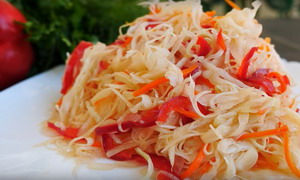 Here are the results. The high fiber group did not change their diversity of gut bugs at all and their inflammatory markers did not change at all over 10 weeks. The researchers commented that a longer feeding period of 6 months to a year might have shown different results. Conversely, the fermented food group got tremendous increases in microbial diversity and all 19 of the inflammatory markers tested went lower. Amazing. The first question that pops to mind is how can adding just a handful of different strains of gut bugs result in an increase in the hundreds of different gut bugs suddenly showing up. They were puzzled too, so they took things to the next level. They analyzed just what specific gut bugs appeared and which ones were new in relation to the ones being consumed. Strangely, only about 10% of the increase in gut bugs was related to what was being consumed. Where did all the rest come from?
Here are the results. The high fiber group did not change their diversity of gut bugs at all and their inflammatory markers did not change at all over 10 weeks. The researchers commented that a longer feeding period of 6 months to a year might have shown different results. Conversely, the fermented food group got tremendous increases in microbial diversity and all 19 of the inflammatory markers tested went lower. Amazing. The first question that pops to mind is how can adding just a handful of different strains of gut bugs result in an increase in the hundreds of different gut bugs suddenly showing up. They were puzzled too, so they took things to the next level. They analyzed just what specific gut bugs appeared and which ones were new in relation to the ones being consumed. Strangely, only about 10% of the increase in gut bugs was related to what was being consumed. Where did all the rest come from?
 The theory is that the influx of good guy bacteria changed the ecology of the gut terrain in a way that favored the appearance of new types of gut bacteria that were probably already there in very small amounts. The improved terrain allowed these suppressed good gut bugs to suddenly grow and thrive. And it was probably these suppressed gut bugs that produced the needed signaling molecules for reducing gut inflammation. Wow, that is amazing. No one expected that!
The theory is that the influx of good guy bacteria changed the ecology of the gut terrain in a way that favored the appearance of new types of gut bacteria that were probably already there in very small amounts. The improved terrain allowed these suppressed good gut bugs to suddenly grow and thrive. And it was probably these suppressed gut bugs that produced the needed signaling molecules for reducing gut inflammation. Wow, that is amazing. No one expected that!
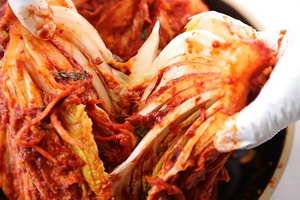 So what foods were the fermented foods group eating? Each subject could choose their own favorite fermented foods, but the most popular were cultured vegetables like kimchi and sauerkraut. Most people also drank the vegetable brine from the fermented vegetables. Kombucha was popular, and kefir, yogurt, and cultured cottage cheese were also good. Other foods that could also be used might be miso, tempeh, natto, and even unpasteurized beer, wine, and sake could be used. Technically salami is a fermented meat product. Every culture in the world has its own local forms of fermented foods. When I visited Japan many years ago, every breakfast included at least 3 to 5 different fermented vegetables. We seem to have lost that deeply important source of our health in our modern American culture. I know I have lost track of fermentation over the last few years. I used to make kombucha, kimchi, and yogurt regularly.
So what foods were the fermented foods group eating? Each subject could choose their own favorite fermented foods, but the most popular were cultured vegetables like kimchi and sauerkraut. Most people also drank the vegetable brine from the fermented vegetables. Kombucha was popular, and kefir, yogurt, and cultured cottage cheese were also good. Other foods that could also be used might be miso, tempeh, natto, and even unpasteurized beer, wine, and sake could be used. Technically salami is a fermented meat product. Every culture in the world has its own local forms of fermented foods. When I visited Japan many years ago, every breakfast included at least 3 to 5 different fermented vegetables. We seem to have lost that deeply important source of our health in our modern American culture. I know I have lost track of fermentation over the last few years. I used to make kombucha, kimchi, and yogurt regularly.
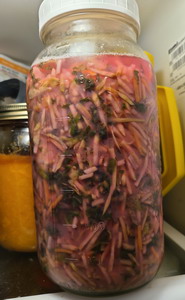 After doing the research for this newsletter, I immediately wandered into my kitchen to start up a batch of fermented vegetables. I thought I would try something new. I had a bag of broccoli shreds and other cruciferous vegetable bits and pieces for making salads. I tossed that up with a few shakes of my Balanced Salt, some purple sweet potato pieces, and a sachet of billions of probiotic bacteria. I spent a few minutes smashing the mixture to break down the fibers and release the inner juices then packed it all in a half-gallon mason jar. I filled that with purified water and put a proper venting seal on it and now it is ready to sit in the corner for a few days and ferment. We shall see how it tastes.
After doing the research for this newsletter, I immediately wandered into my kitchen to start up a batch of fermented vegetables. I thought I would try something new. I had a bag of broccoli shreds and other cruciferous vegetable bits and pieces for making salads. I tossed that up with a few shakes of my Balanced Salt, some purple sweet potato pieces, and a sachet of billions of probiotic bacteria. I spent a few minutes smashing the mixture to break down the fibers and release the inner juices then packed it all in a half-gallon mason jar. I filled that with purified water and put a proper venting seal on it and now it is ready to sit in the corner for a few days and ferment. We shall see how it tastes.
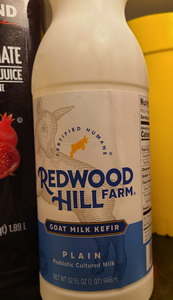 I also went to the store to pick up some plain organic yogurt, goat milk kefir, cultured cottage cheese, and ginger kombucha. The results of that study really impressed me. I want those good inflammation-dampening results for myself. In the study, the participants consumed six servings of fermented food each day, so that is what I am aiming for myself. Gut health is key to health all over the body. I can add a few servings of fermented foods to my diet to support that cause. How about you?
I also went to the store to pick up some plain organic yogurt, goat milk kefir, cultured cottage cheese, and ginger kombucha. The results of that study really impressed me. I want those good inflammation-dampening results for myself. In the study, the participants consumed six servings of fermented food each day, so that is what I am aiming for myself. Gut health is key to health all over the body. I can add a few servings of fermented foods to my diet to support that cause. How about you?
 Important note — the idea is to be eating food that is still alive, so no cooking your fermented food. That would destroy the good guy bugs and eliminate the benefit you are seeking. And remember, those study participants saw huge changes in only 10 weeks. If I see those kinds of changes that rapidly then that will definitely motivate me to keep this fermented lifestyle up. So hey, give it a try!
Important note — the idea is to be eating food that is still alive, so no cooking your fermented food. That would destroy the good guy bugs and eliminate the benefit you are seeking. And remember, those study participants saw huge changes in only 10 weeks. If I see those kinds of changes that rapidly then that will definitely motivate me to keep this fermented lifestyle up. So hey, give it a try!
Take care,
David
Ellen 
Halloween has come and gone. We see Ellen ready and waiting to hand out gummy bears to the little kiddies. We had a pretty disappointing showing this year, only six kids. What are we going to do with all those left over gummy bears?
 CBD speeds bone fracture healing
CBD speeds bone fracture healing
 Death risk from sitting moderated
Death risk from sitting moderated
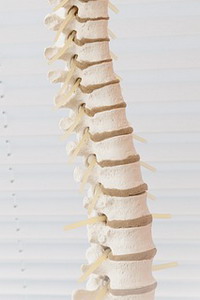 Exercise for healing discs!
Exercise for healing discs!

 The big new frontier in biomedicine is the vast landscape of the microbiome. Although it only amounts to a few pounds of muck in your colon, it contains 90% of the genetic material (DNA and RNA) in your body. There are thousands of different bacteria, fungi, and viruses that live in a healthy colon. More importantly, they are not just hanging out getting a free ride, shelter, and food stamps. The microbiome functions as a complex endocrine organ by producing all sorts of signaling molecules that control various aspects of our body as well as manufacture the primary food the cell of our colon eats – short-chain fatty acids.
The big new frontier in biomedicine is the vast landscape of the microbiome. Although it only amounts to a few pounds of muck in your colon, it contains 90% of the genetic material (DNA and RNA) in your body. There are thousands of different bacteria, fungi, and viruses that live in a healthy colon. More importantly, they are not just hanging out getting a free ride, shelter, and food stamps. The microbiome functions as a complex endocrine organ by producing all sorts of signaling molecules that control various aspects of our body as well as manufacture the primary food the cell of our colon eats – short-chain fatty acids. Our brain controls the body through nerve impulses, the glands through hormones, and the gut through signaling molecules. They all work together to produce either health or disease. The gut is particularly sensitive to generating disease for us because different bacteria, fungi, and viruses produce different results, some good and some bad. Which type of bacteria we have growing inside our gut depends upon what we eat and how much stress we are under. As always, everything affects everything else in the body. One consistent finding that has been showing up is that the more healthy you are the greater the diversity of gut bacteria you have. The less variety of gut bacteria you have, the more prone to sickness you are.
Our brain controls the body through nerve impulses, the glands through hormones, and the gut through signaling molecules. They all work together to produce either health or disease. The gut is particularly sensitive to generating disease for us because different bacteria, fungi, and viruses produce different results, some good and some bad. Which type of bacteria we have growing inside our gut depends upon what we eat and how much stress we are under. As always, everything affects everything else in the body. One consistent finding that has been showing up is that the more healthy you are the greater the diversity of gut bacteria you have. The less variety of gut bacteria you have, the more prone to sickness you are. There is also the issue of just what strains of bacteria you have living inside you. Bad guy bacteria love to eat junk food while good guy bacteria like fiber foods. This has led some people to assume that this means we should eat only plants, but in reality, the connective tissue in muscle meats is also a type of fiber to the good guy bacteria. Nevertheless, many unprocessed plant foods are high in fiber and do support a healthy gut microbiome. This understanding has led the government to recommend that we consume at least 25 grams of fiber each day, although 50 to 100 grams would be even better. Most Americans eat less than 15 grams of fiber per day.
There is also the issue of just what strains of bacteria you have living inside you. Bad guy bacteria love to eat junk food while good guy bacteria like fiber foods. This has led some people to assume that this means we should eat only plants, but in reality, the connective tissue in muscle meats is also a type of fiber to the good guy bacteria. Nevertheless, many unprocessed plant foods are high in fiber and do support a healthy gut microbiome. This understanding has led the government to recommend that we consume at least 25 grams of fiber each day, although 50 to 100 grams would be even better. Most Americans eat less than 15 grams of fiber per day. These recommendations were based on logical thinking, not actual intervention studies. Dietary intervention studies are very difficult to perform because it is very difficult to get people to actually eat differently than they are used to. Lots of observational studies show what I mentioned above – high diversity of good guy bacteria is associated with better health outcomes. But this does not prove that this actually causes greater health. Well, just last week a study performed by Stanford tried to study this very subject. High fiber consumption is associated with better health outcomes, as is the consumption of high-probiotic foods. The question that has been running around for years now is which is better for you, a high-fiber diet or a diet high in fermented high-probiotic food. Or in other words, feed the good guys you already have or constantly dump in new loads of good guys? Here is a link to the results:
These recommendations were based on logical thinking, not actual intervention studies. Dietary intervention studies are very difficult to perform because it is very difficult to get people to actually eat differently than they are used to. Lots of observational studies show what I mentioned above – high diversity of good guy bacteria is associated with better health outcomes. But this does not prove that this actually causes greater health. Well, just last week a study performed by Stanford tried to study this very subject. High fiber consumption is associated with better health outcomes, as is the consumption of high-probiotic foods. The question that has been running around for years now is which is better for you, a high-fiber diet or a diet high in fermented high-probiotic food. Or in other words, feed the good guys you already have or constantly dump in new loads of good guys? Here is a link to the results:  The study only lasted 10 weeks, but the results blew everybody away. They did a very thorough job with this study, doing a full genetic analysis of the gut bacteria in every person before the study began and again at the end. They also tested for 19 different inflammatory markers in the gut that would indicate whether either diet was actually helping the subjects. Half the subjects increased their fiber consumption by quite a bit up to an average of 40 grams of fiber a day. They ate a high-fiber diet rich in legumes, seeds, whole grains, nuts, vegetables and fruits. The other group increased their consumption of fermented foods almost 6 fold on average. Daily individual food logs allowed the researchers to look at individual differences between subjects as a deeper dive into the results of this study.
The study only lasted 10 weeks, but the results blew everybody away. They did a very thorough job with this study, doing a full genetic analysis of the gut bacteria in every person before the study began and again at the end. They also tested for 19 different inflammatory markers in the gut that would indicate whether either diet was actually helping the subjects. Half the subjects increased their fiber consumption by quite a bit up to an average of 40 grams of fiber a day. They ate a high-fiber diet rich in legumes, seeds, whole grains, nuts, vegetables and fruits. The other group increased their consumption of fermented foods almost 6 fold on average. Daily individual food logs allowed the researchers to look at individual differences between subjects as a deeper dive into the results of this study. Here are the results. The high fiber group did not change their diversity of gut bugs at all and their inflammatory markers did not change at all over 10 weeks. The researchers commented that a longer feeding period of 6 months to a year might have shown different results. Conversely, the fermented food group got tremendous increases in microbial diversity and all 19 of the inflammatory markers tested went lower. Amazing. The first question that pops to mind is how can adding just a handful of different strains of gut bugs result in an increase in the hundreds of different gut bugs suddenly showing up. They were puzzled too, so they took things to the next level. They analyzed just what specific gut bugs appeared and which ones were new in relation to the ones being consumed. Strangely, only about 10% of the increase in gut bugs was related to what was being consumed. Where did all the rest come from?
Here are the results. The high fiber group did not change their diversity of gut bugs at all and their inflammatory markers did not change at all over 10 weeks. The researchers commented that a longer feeding period of 6 months to a year might have shown different results. Conversely, the fermented food group got tremendous increases in microbial diversity and all 19 of the inflammatory markers tested went lower. Amazing. The first question that pops to mind is how can adding just a handful of different strains of gut bugs result in an increase in the hundreds of different gut bugs suddenly showing up. They were puzzled too, so they took things to the next level. They analyzed just what specific gut bugs appeared and which ones were new in relation to the ones being consumed. Strangely, only about 10% of the increase in gut bugs was related to what was being consumed. Where did all the rest come from? The theory is that the influx of good guy bacteria changed the ecology of the gut terrain in a way that favored the appearance of new types of gut bacteria that were probably already there in very small amounts. The improved terrain allowed these suppressed good gut bugs to suddenly grow and thrive. And it was probably these suppressed gut bugs that produced the needed signaling molecules for reducing gut inflammation. Wow, that is amazing. No one expected that!
The theory is that the influx of good guy bacteria changed the ecology of the gut terrain in a way that favored the appearance of new types of gut bacteria that were probably already there in very small amounts. The improved terrain allowed these suppressed good gut bugs to suddenly grow and thrive. And it was probably these suppressed gut bugs that produced the needed signaling molecules for reducing gut inflammation. Wow, that is amazing. No one expected that! So what foods were the fermented foods group eating? Each subject could choose their own favorite fermented foods, but the most popular were cultured vegetables like kimchi and sauerkraut. Most people also drank the vegetable brine from the fermented vegetables. Kombucha was popular, and kefir, yogurt, and cultured cottage cheese were also good. Other foods that could also be used might be miso, tempeh, natto, and even unpasteurized beer, wine, and sake could be used. Technically salami is a fermented meat product. Every culture in the world has its own local forms of fermented foods. When I visited Japan many years ago, every breakfast included at least 3 to 5 different fermented vegetables. We seem to have lost that deeply important source of our health in our modern American culture. I know I have lost track of fermentation over the last few years. I used to make kombucha, kimchi, and yogurt regularly.
So what foods were the fermented foods group eating? Each subject could choose their own favorite fermented foods, but the most popular were cultured vegetables like kimchi and sauerkraut. Most people also drank the vegetable brine from the fermented vegetables. Kombucha was popular, and kefir, yogurt, and cultured cottage cheese were also good. Other foods that could also be used might be miso, tempeh, natto, and even unpasteurized beer, wine, and sake could be used. Technically salami is a fermented meat product. Every culture in the world has its own local forms of fermented foods. When I visited Japan many years ago, every breakfast included at least 3 to 5 different fermented vegetables. We seem to have lost that deeply important source of our health in our modern American culture. I know I have lost track of fermentation over the last few years. I used to make kombucha, kimchi, and yogurt regularly. After doing the research for this newsletter, I immediately wandered into my kitchen to start up a batch of fermented vegetables. I thought I would try something new. I had a bag of broccoli shreds and other cruciferous vegetable bits and pieces for making salads. I tossed that up with a few shakes of my Balanced Salt, some purple sweet potato pieces, and a sachet of billions of probiotic bacteria. I spent a few minutes smashing the mixture to break down the fibers and release the inner juices then packed it all in a half-gallon mason jar. I filled that with purified water and put a proper venting seal on it and now it is ready to sit in the corner for a few days and ferment. We shall see how it tastes.
After doing the research for this newsletter, I immediately wandered into my kitchen to start up a batch of fermented vegetables. I thought I would try something new. I had a bag of broccoli shreds and other cruciferous vegetable bits and pieces for making salads. I tossed that up with a few shakes of my Balanced Salt, some purple sweet potato pieces, and a sachet of billions of probiotic bacteria. I spent a few minutes smashing the mixture to break down the fibers and release the inner juices then packed it all in a half-gallon mason jar. I filled that with purified water and put a proper venting seal on it and now it is ready to sit in the corner for a few days and ferment. We shall see how it tastes. I also went to the store to pick up some plain organic yogurt, goat milk kefir, cultured cottage cheese, and ginger kombucha. The results of that study really impressed me. I want those good inflammation-dampening results for myself. In the study, the participants consumed six servings of fermented food each day, so that is what I am aiming for myself. Gut health is key to health all over the body. I can add a few servings of fermented foods to my diet to support that cause. How about you?
I also went to the store to pick up some plain organic yogurt, goat milk kefir, cultured cottage cheese, and ginger kombucha. The results of that study really impressed me. I want those good inflammation-dampening results for myself. In the study, the participants consumed six servings of fermented food each day, so that is what I am aiming for myself. Gut health is key to health all over the body. I can add a few servings of fermented foods to my diet to support that cause. How about you? Important note — the idea is to be eating food that is still alive, so no cooking your fermented food. That would destroy the good guy bugs and eliminate the benefit you are seeking. And remember, those study participants saw huge changes in only 10 weeks. If I see those kinds of changes that rapidly then that will definitely motivate me to keep this fermented lifestyle up. So hey, give it a try!
Important note — the idea is to be eating food that is still alive, so no cooking your fermented food. That would destroy the good guy bugs and eliminate the benefit you are seeking. And remember, those study participants saw huge changes in only 10 weeks. If I see those kinds of changes that rapidly then that will definitely motivate me to keep this fermented lifestyle up. So hey, give it a try!